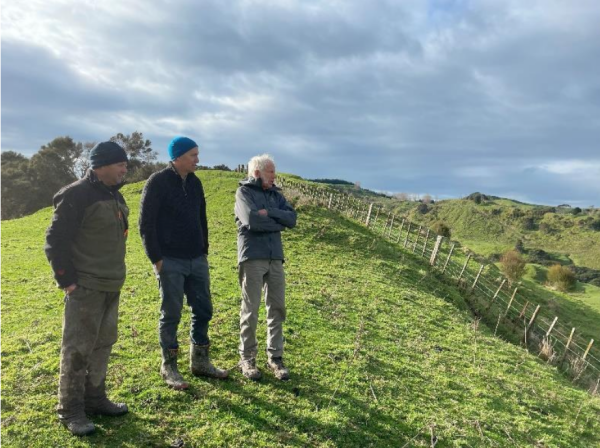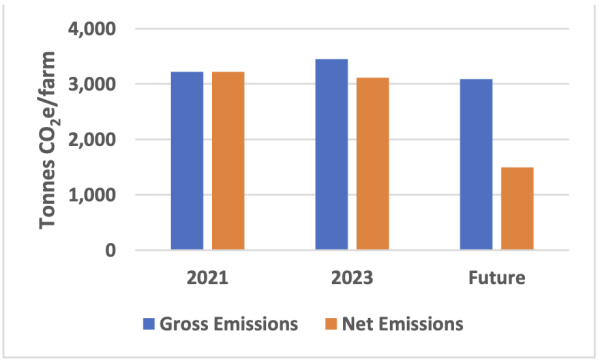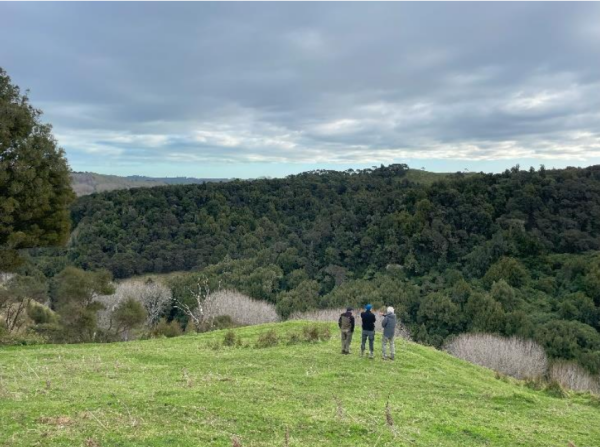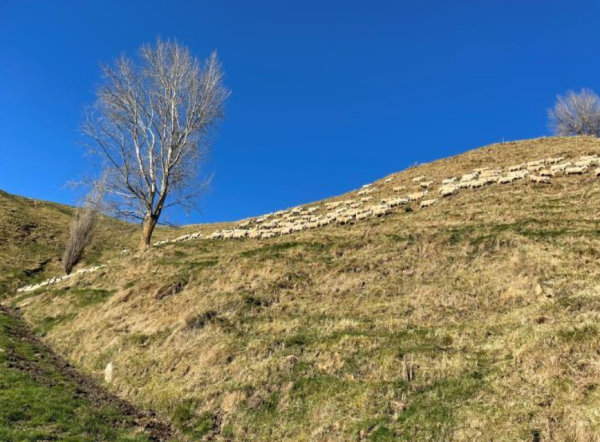Oxton Farm, Manawatū/Whanganui
Over 60 years of farming, Nick Tripe has established a 1,325 hectare (936ha effective pasture and 245ha productive mānuka) hill country property located between Whanganui and Hunterville. The property is rich in history, with the family farming the original block in 1928, and has grown over time to the enterprise it is today.
Video
Download this story
Download a copy of the Oxton Farms story here [PDF, 924 KB]
About the farm
Nick oversaw a farm succession process which culminated in ownership of the farm being transferred to his son Johnny and daughter-in-law Emmeline in 2023.
Table 1: Oxton land area (ha)
| Enterprise |
Land area (ha) |
| Sheep and beef | 936 |
| Mānuka | 245 |
| Retired native forest | 120 |
| Non-productive (races, drains) etc | 24 |
| Total |
1,325 |
Table 2: Capital stock nu,bers and production
| 2021 | 2023 | Future | |
| Effective ha | 1084 | 1012 | 936 |
| Breeding ewes | 4370 | 4443 | 4064 |
| Breeding cows | 170 | 200 | 160 |
| Total SU | 9254 | 9036 | 8432 |
| SU/ha | 8.5 | 8.9 | 9.0 |
| Net production (kg/eff ha) | 132 | 160 | 194 |
The property is predominantly medium to steep hill country with smaller areas of finishing land. The farm system is based around 4,500 romney/coopworth breeding ewes, replacements, and selling progeny. Two-hundred angus cows are run on the farm, with surplus progeny sold as two-year olds. Additional income comes from a mānuka honey profit share arrangement with a honey producer.
What changes have been made?
Oxton’s greenhouse gas (GHG) reduction policy is retiring marginal farmland to indigenous forestry, diversifying land use, and optimising the livestock system focusing on stock unit performance on the most productive land to match its environmental capabilities.

This has resulted in an increase in stocking rate on the remaining better land, but a decrease in overall stock unit numbers.
Lower performing country has been retired or planted in mānuka to integrate into the Emissions Trading Scheme (ETS), resulting in more productive land use for all land types. This retired land is offsetting some of the emissions on the remaining livestock productive land.
Why were the changes made?
The incentive for emissions reductions and other environmental investment is the satisfaction of the owners and wider family. While the Tripes endeavour to optimise productivity and profitability, they are aware of the need to reduce the environmental footprint of the farming operation.

They strive to enhance profitability from alternative land use and embrace greenhouse gas mitigation technology in the livestock system. The Tripes expect that environmental assurance certifications will reward the business with a market premium for its product.
Measures to optimise productivity will allow for production levels to be maintained, with a smaller number of animals and land area, and mānuka planting offsetting the increase in GHG emissions.
GHG modelling method
The farm was modelled in Farmax for the three years being analysed.
What have been the impacts of the changes?
Figure 1: Gross versus net biological emissions (methane and nitrous oxide) across the whole farm.

Table 2: Oxton GHG profile
|
2021 |
2023 |
Future |
% Change future vs 2021 |
|
|
Total biological emissions (T CO2e/farm) |
3219 | 3451 | 3089 | -4% |
|
Methane (T CO2e/ha) |
2.43 | 2.78 | 2.69 | 11% |
|
Methane (kg CH4/ha) |
97 | 111 | 108 |
11% |
|
Nitrous oxide (T CO2e/ha) |
0.54 | 0.63 | 0.61 | 13% |
|
Sequestration (T CO2e/farm) |
0 | 338 | 1593 | |
|
Net emissions (T CO2e/farm) |
3219 | 3113 | 1496 | -54% |
As shown above in Table 2, emissions per hectare have increased due to the higher stocking rate on the better land, although the expectation is that gross biological emissions will reduce (by 4 percent) due to the lower total stock numbers.
The net GHG emissions reduction is due to the change of land use on the poorer classes of land. Note that while the forest is registered in the ETS, in order to claim carbon credits, these credits cannot be sold if the farm is claiming them as an offset.
The planting of 245 hectares of māanuka is modelled to sequester 1,593T CO²e/yr in the future, decreasing net emissions (gross emissions from the farm, less carbon sequestered by the forest) to 1,496T CO²e/yr, which is a 54 percent decrease in net emissions since 2021.
The emissions profile and environmental footprint has been at the forefront of the strategy for Oxton Farm. It is rewarding for the Tripes to be making inroads in offsetting their emissions while also maximising the productive capacity of their asset. This is proving to be a more financially viable and complete business model for the family.
What process did they go through to make the changes?
The Tripes have utilised the changes below to improve their on-farm GHG footprint.
- Farmax modelling for systems optimisation.
- Identify alternative land use strategies and the retirement of non-productive areas.
- Introduce genetics changes to increase fecundity and survival.
- Introduce variable rate fertiliser application to match fertiliser inputs with requirements.
- Carbon sequestration mapping to identify areas eligible for the ETS.
What other changes are planned?
The Tripes see further opportunity to identify existing scrub on marginal land which could be left to regenerate to ETS eligible size, extending their carbon sequestration profile.
Areas outside ETS eligibility and low erosion risk areas will be maintained for productive livestock farming.
Stocking rate is at an optimal level to work alongside the natural resource of the farm. Increased improvement in reproduction and liveweight gain of stock is a continued goal, with low emissions genetics being explored when commercially viable.
What drives or constrains these changes?

Emissions reduction and financial gain are equally essential factors when developing system changes to enable the farm to play a long-term role in reducing greenhouse gas emissions. To date these changes have had substantial offsetting benefits while creating a diverse and profitable business, enabling developments to occur at scale.
The land class and climate of Oxton Farm present challenges and limit production, meaning continued research will be essential to uncover further opportunities.
What are they doing to ensure climate resilience for Oxton?
- Removing livestock from the most erodible/low performing pastoral land where biological emissions are high in relation to livestock production.
- Increasing the efficiency of remaining livestock through body condition scoring, non-negotiable
targets for young stock and better utilisation of grazed pastures. - Marketing store stock earlier to reduce the amount of maintenance feeding.
- Variable rate fertiliser application to match input with requirements.
- Integration of scrub in erosion vulnerable areas (to be included in the ETS).
- Retiring of native and wetland areas.
- Create a collaborative and inclusive approach especially when working towards an improved wider area such as a river catchment.
- Be open minded to all options available and the range of benefits they can provide.
What advice do they have for other farmers?

- Create a team of people with different areas of expertise to add valuable advice and support throughout the process.
- Use tools available to you to analyse changing scenarios and make calculated decisions. Tools such as Farmax modelling and digital mapping software have helped significantly in Oxton’s system development.
- Utilise regional councils or other support services to help with knowledge sharing and funding options.
- Include the local community and iwi where possible.
Published: July 22, 2025

